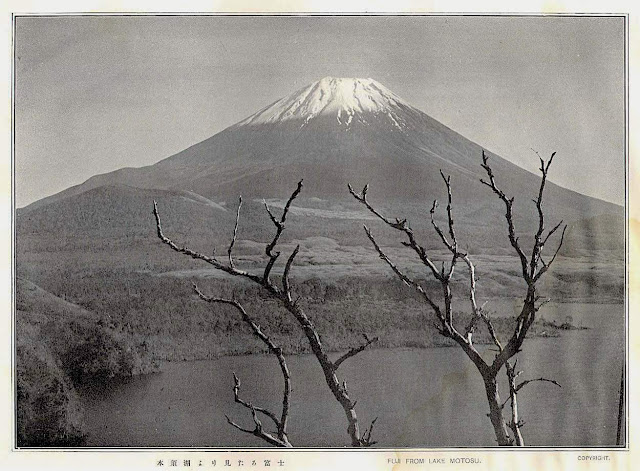%20-%20Mount%20Fuji%20mist%20and%20bamboos,.png)
Fujiyama / 富士山 (3, 776 m)
Japon
In Mount Fuji mist and bamboos, 1950, photo
Le photographe
Kōyō Okada (岡 田紅陽) est
un photographe japonais, lauréat de l'édition 1954 du Japan Photography
Society Award. Koyo Okada a consacré toute sa vie à photographier le
mont Fuji.
Il photographiait le Mont Fuji, vêtu d'un kimono provenant
de son hôtel de style japonais préféré, et ses voisins l'appelaient «
Koyo-san » . Il est né à Uonuma, dans la préfecture de Nigata, et son
arrière-grand-père, son grand-père et son père étaient artistes. Il
s'est intéressé à la photos lorsqu'il était à l'université Waseda et il
a siasi le mont Fuji vu du village d'Oshino à l'âge de 21 ans. Depuis
lors, une relation de plus de 50 ans avec le Mont Fuji a commencé.
Le légendaire mont Fuji ou Fujiyama (富士山) est situé sur l'île de Honshu et est le plus haut sommet du Japon à 3 776,24 m (12 389 pieds). Plusieurs noms lui sont attribués : « Fuji-san », « Fujiyama » ou, de manière redondante, « Mont Fujiyama ». Habituellement, les japonais appellent la montagne « Fuji-san ». Les autres noms japonais du Mont Fuji, sont devenus obsolètes comme : Fuji-no-Yama (ふじの山 - La Montagne du Fuji), Fuji-no-Takane (ふじの高嶺 - Le Haut Sommet du Fuji), Fuyō-hō ( 芙蓉峰 - Le Pic du Lotus), et Fugaku (富岳/富嶽), créés en combinant le premier caractère de 富士, Fuji, et 岳, montagne.
Le mont Fuji est un stratovolcan actif dont la dernière éruption remonte à 1707-1708. Le mont Fuji se trouve à environ 100 kilomètres (60 mi) au sud-ouest de Tokyo et peut être vu de là par temps clair.
Le cône exceptionnellement symétrique du mont Fuji, recouvert de neige plusieurs mois par an, est un symbole bien connu du Japon et est fréquemment représenté dans les œuvres d'art et les photographies, ainsi que visité par les touristes et les grimpeurs.
Le mont Fuji est l'une des trois montagnes sacrées du Japon (三霊山) avec le mont Tate et le mont Haku. C'est également un lieu spécial d'une beauté pittoresque et l'un des sites historiques du Japon.
Il a été ajouté à la Liste du patrimoine mondial en tant que site culturel le 22 juin 2013. Selon l'UNESCO, le mont Fuji « a inspiré les artistes et les poètes et fait l'objet de pèlerinage depuis des siècles ». L'UNESCO reconnaît 25 sites d'intérêt culturel dans la localité du mont Fuji. Ces 25 sites comprennent la montagne elle-même, le sanctuaire Fujisan Hongū Sengen et six autres sanctuaires Sengen, deux maisons d'hébergement, le lac Yamanaka, le lac Kawaguchi, les huit sources chaudes d'Oshino Hakkai, deux moules d'arbres de lave, les vestiges du culte Fuji-kō dans le Grotte Hitoana, chutes Shiraito et pinède Miho no Matsubara ; tandis que sur les basses Alpes du mont Fuji se trouve le complexe du temple Taisekiji, où se trouve le siège central du bouddhisme Nichiren Shoshu.
,%20Oxford,%20Bodleian%20Library.,.png)

-Tsukada_Island_in_the_Musashi_province%20n%C2%B0%2016-%201830.jpg)
%20-%20Three%20views%20of%20Mt%20Fuji%20.jpg)
%20Fujiyama,%201935%20%20Cardboard,%20tempera.%2030.8%20x%2046.1.jpg)

%20-%20Mount%20Fuji,.jpg)

%20Summit%20of%20Fuji%20Series-%20Ten%20Views%20of%20Fuji-%20Woodblock%20Print.png)
%20-%20Mount%20Haku,%20Kaga%20Province,%20%20Woodblock%20Print,%20%201862-%20in%20Sixty-eight%20Views%20of%20the%20Various%20Provinces,%201862.jpg)








